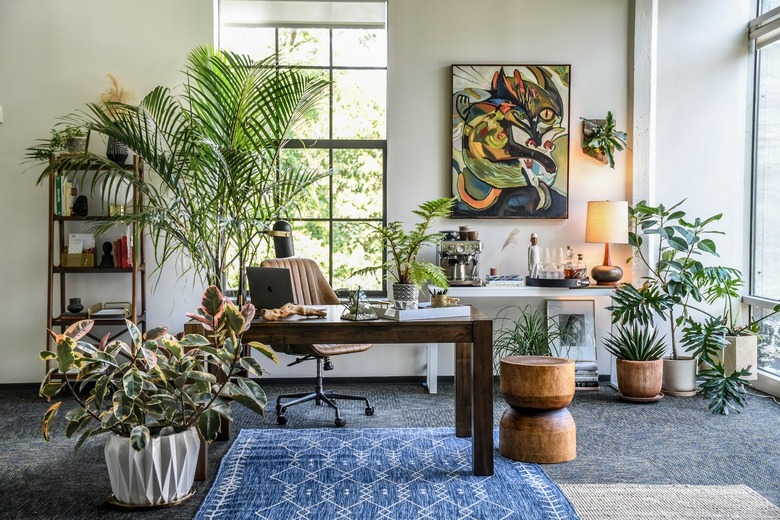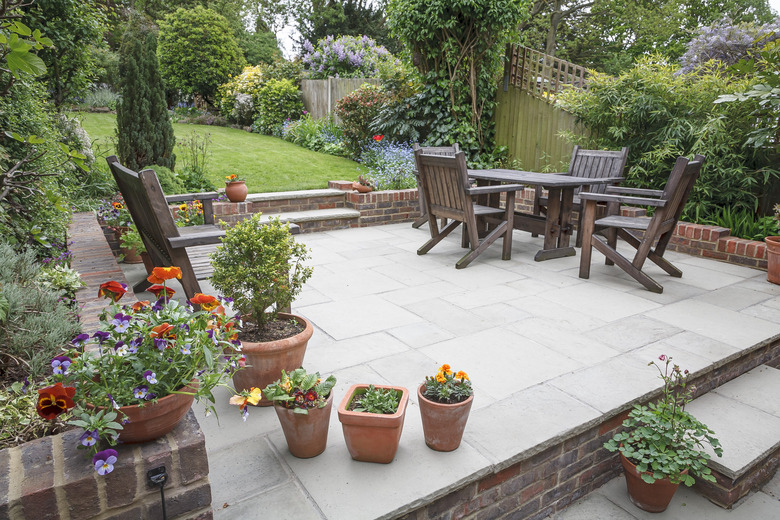A Beginner's Guide To Buying Plants
We may receive a commission on purchases made from links.
Buying plants is an absolute joy. However, it can also be overwhelming if you're entirely new to gardening. A green thumb doesn't grow overnight, after all. There are a ton of points to keep in mind when shopping for plants, and you'll need to decide where to source your plants as well as which ones to buy.
You also need to pick plants according to your goals. Do you want an easy-to-maintain houseplant, or are you searching for a plant to fit a shaded outdoor area? With some practice (and inevitable disappointment), you'll quickly become a plant-buying pro.
However, it won't always end well. You'll kill some plants by being overzealous or neglectful, and you might bring home diseased or pest-ridden plants. It happens even if you're extra careful. Shopping for new plants doesn't have to leave you with a headache — it can be a fun, eye-opening experience.
Where to Research the Best Plant Types
Where to Research the Best Plant Types
Before heading off on your plant-shopping excursion, you should do some research. Vegetable gardeners can find plenty of information about edible plant types using online resources, like university extension websites. Seed sellers are another excellent resource.
If you're interested in houseplants, numerous plant care apps outline specific plant needs. They'll also help you care for your chosen plants once you bring them home. Planta is a fantastic app that offers visual plant identification and daily to-do lists with important plant-care tasks. While impulse buying isn't ideal, you can use the app to quickly identify cool plants while you shop. In an instant, you can figure out whether the plant will thrive in your home's environment. Planta will notify you if a plant is poorly suited to a specific room. If you set your kitchen as "sunny" and "humid," for example, the app can quickly let you know if a plant is right for that space.
Local garden clubs are another helpful resource. People who are part of these organizations have a wealth of knowledge to share. Clubs also often hold plant sales or swaps where you can ask questions and even trade plants, cuttings and seeds. Online gardening communities on Facebook and Instagram are also full of eager people who help budding gardeners. They can give you plant-buying tips based on real-world experience.
Selecting the Right Plant for Specific Areas/Goals
Selecting the Right Plant for Specific Areas/Goals
Research potential plant options and plan before you buy. Consider the following:
- Sun exposure: Know your environment. Whether you plan to plant outside or indoors, you need to know sun exposure levels around your home and property. If you have a shaded apartment, sun-loving succulents and cacti are a poor houseplant choice.
- Space: How much square footage do you have available? This is especially important for outdoor planting situations. Do you want to plant a fruit tree? You might need more space than you think since many fruit trees require two varieties for cross-pollination.
- Soil: If you're buying plants for the outdoors, you need to know what kind of soil you're dealing with. Some plants prefer porous, sandy soils. Others will thrive in various soils as long as their sunlight needs are met. If you plan to grow in pots or raised beds, soil type is less of an issue since you can customize it yourself.
Before you set out on your plant-shopping adventure (online or in person), you also need to know why you're buying a plant. The best plant is the one that fits your needs. The question of "why?" is multifaceted. It involves asking yourself:
- What is the purpose of this plant? Is it decorative or edible? Is it for indoors or outside? Do you need it to survive the winter?
- With what level of maintenance are you comfortable? Avoid plants with high water needs if you're forgetful or don't want to babysit your houseplants. Skip buying perennials with fussy pruning requirements and opt for plants that need minimal shaping and upkeep.
You should have an idea of whether you want to house the plant indoors or outside. An indoor environment is easier to manipulate. Outdoors is a bit more unpredictable. A majesty palm (Ravenea rivularis, USDA zones 10-11) won't survive outside all year in zone 5, for instance. In colder climates, it's more of an indoor plant.
Your options will be limited to your climate or microclimate, which is an area of your garden or property where the growing conditions are significantly different than in other local areas. The space under a home's eaves might not receive any precipitation, making it necessary to choose drought-tolerant plants for that spot.
Of course, you don't need to have everything figured out before you start shopping. Buying plants is an involved process. It might take a few visits and lots of questions before you make all your selections.
What to Look For in a Plant
What to Look For in a Plant
When buying plants, look for options with labels. Labels can provide you with a lot of useful information, including the suitable climate and temperature preferences. Most plants have tags that at the very least tell you its USDA hardiness zones. Labels may also include soil and water needs and whether a plant is perennial or not. If in doubt, ask an employee at the garden center or greenhouse.
Once you've decided which plants are the right fit for your needs and space, take a moment; it's not time to head to the checkout yet. You need to carefully examine each plant for pests and disease. Bringing home a plant that's riddled with insects is not ideal — those bugs can hitch a ride and infect other plants you might have at home. Plus, an insect-filled plant isn't likely to be healthy. Insects can weaken plants or introduce disease.
You should also watch out for disease. It's always a disappointment when a plant you've brought home dies only a few weeks later. It can also certainly make newbie gardeners feel incredibly discouraged. Avoid disappointment by assessing plant leaves and roots. Does everything look healthy? Check the root ball or root system. Is the plant root-bound? Check for discoloration on foliage and any signs of declining health, like stunted growth or leaf drop. If there are multiples of one plant, it should be evident if one is unhealthy. Some signs of disease include:
- Yellowing leaves
- Foliage drop
- Brown spots or discoloration on leaves
- White spots on leaves
- Poor growth compared to other plants
- Stunted appearance
Although it sounds counterintuitive, avoid plants in bloom. It's tempting, but blooming plants may lose their luster once you've transplanted them. You'll enjoy the showy flowers for longer if you pick a nonblooming plant. Beyond blooms, you should also consider size, as there are pros and cons to selecting larger plants. Bigger plants are often significantly more expensive, and you may not want to spend too much on a plant that may die if you're not confident in your gardening skills. However, large perennial plants require less attention once transplanted because they've already developed a healthy root system.
Finally, don't forget to consider your pets. If you live with any furry or feathered friends, some plants can be hazardous. Domestic animals aren't hardwired to know what is good or bad for them, so you have to do the work. If in doubt, contact your local veterinarian. Some vet office websites have comprehensive lists of safe and toxic plants for pets. Understanding that many plant buyers are concerned about pet safety, some online plant retailers allow you to filter plants and only view pet-friendly options.
How to Ask Questions at the Garden Center
How to Ask Questions at the Garden Center
Not all plants have detailed labels. If you want more information, ask a staff member for help. Questions you might ask include:
- Is this plant native to the area?
- How much light does it need? Can it tolerate low light or shade?
- Is it perennial or annual?
- How big will it get?
- What color are the blooms?
- When does it bloom?
- How much space does it need?
- Is it a high-maintenance plant? What kind of plant care does it need?
Ask whether the shop offers a plant guarantee. Some plant sellers will guarantee the health of a plant (with some exceptions) for the first week or two of its life in your home.
If you're buying vegetable seedlings, ask whether they're already hardened off. If so, you can plant them directly in the ground. If not, you'll need to slowly acquaint them with outdoor conditions, which takes extra time and effort that not everyone has available.
Picking the Right Experts
Picking the Right Experts
Thanks to the internet, there are now more places to source plants than ever before. Buying plants has never been easier. You can grab cuttings from online marketplaces like eBay and Etsy. You can find plant lovers with whom to trade in Facebook groups. Countless companies will safely ship healthy plants right to your doorstep. The disadvantage of buying online is that you can't inspect your plants beforehand. However, buying online does allow you to do plenty of research before you purchase, and many online plant sellers are happy to answer your burning plant questions.
You can also buy plants locally. Both local plant shops and big-box stores offer a selection of houseplants, seedlings and saplings. Big-box stores, like Home Depot, often sell plants at very affordable prices. Still, their provenance is sometimes tricky to track down. You're also unlikely to find expert help readily available at a big-box store. As the wisdom goes, "you get what you pay for."
Local nurseries run the gamut. Some are staffed with knowledgeable, friendly staff that can help you find what you need and can answer your burning plant questions. Others are just looking to make a quick buck and will sell you whatever they can.
Read store reviews or ask local gardeners and gardening clubs for their input to get a sense of which stores offer the best customer service. Whether you're shopping online or in person, you should look for a seller with a good reputation. Many plant sellers are passionate growers. While there are certainly some bad apples, many small businesses and local nurseries aren't looking to scam you.
For impartial advice, your best bet is to contact your local cooperative extension service. Located across the United States, these offices have staff and volunteers available to answer your garden-related questions. They don't sell plants, so they're an excellent source for information about region-specific plants.

